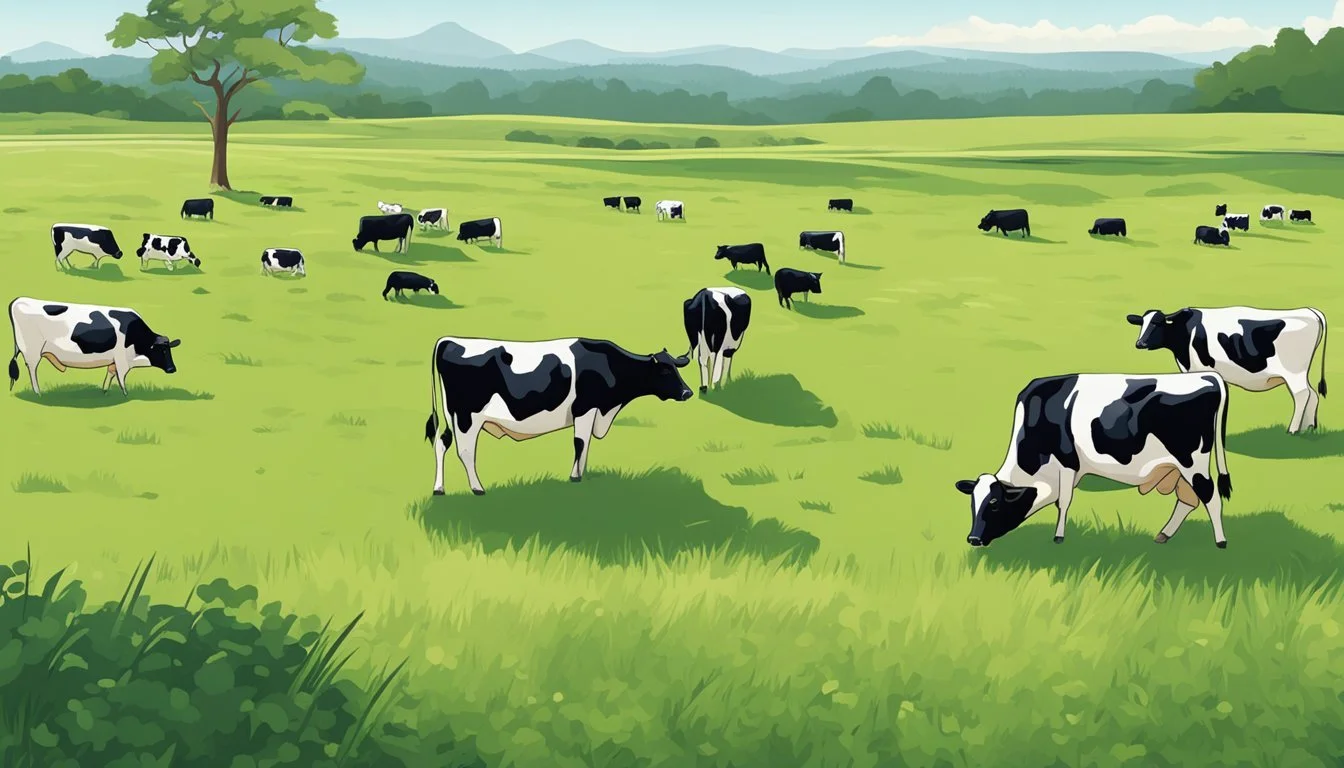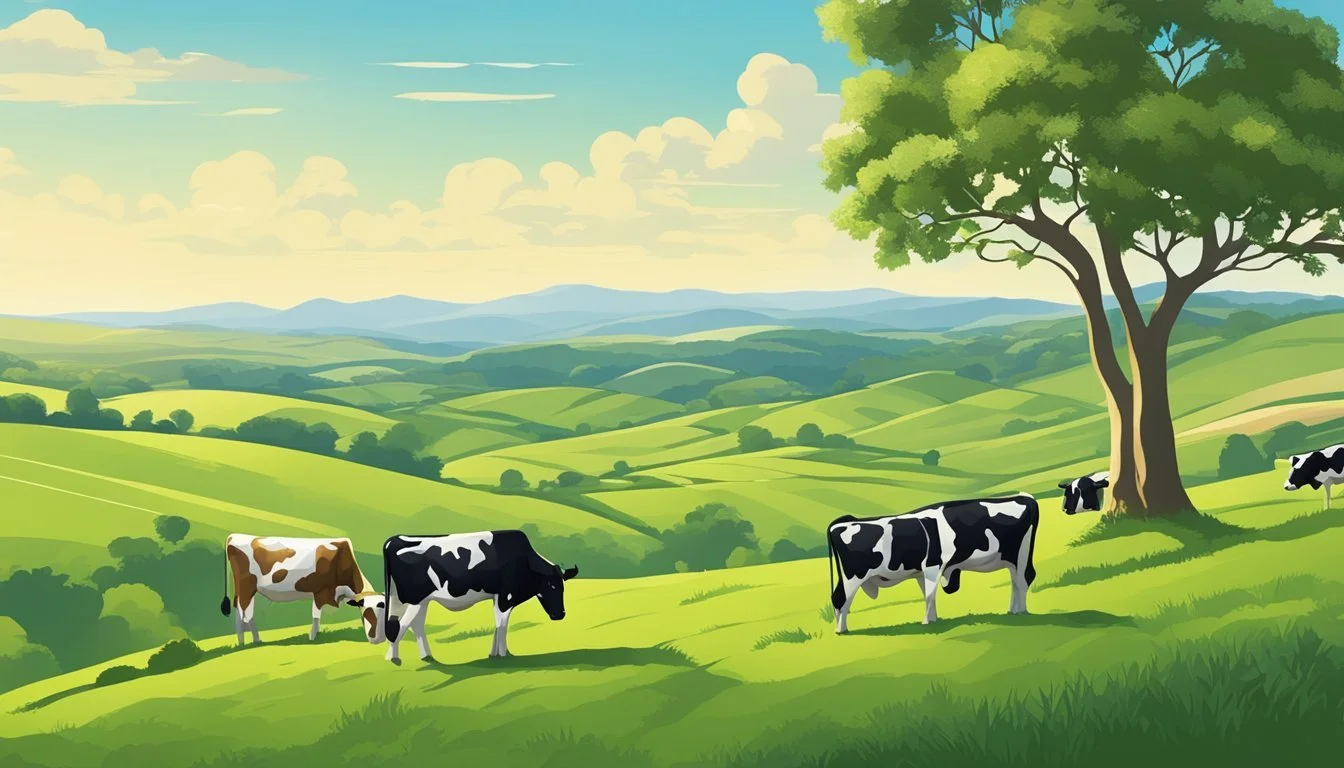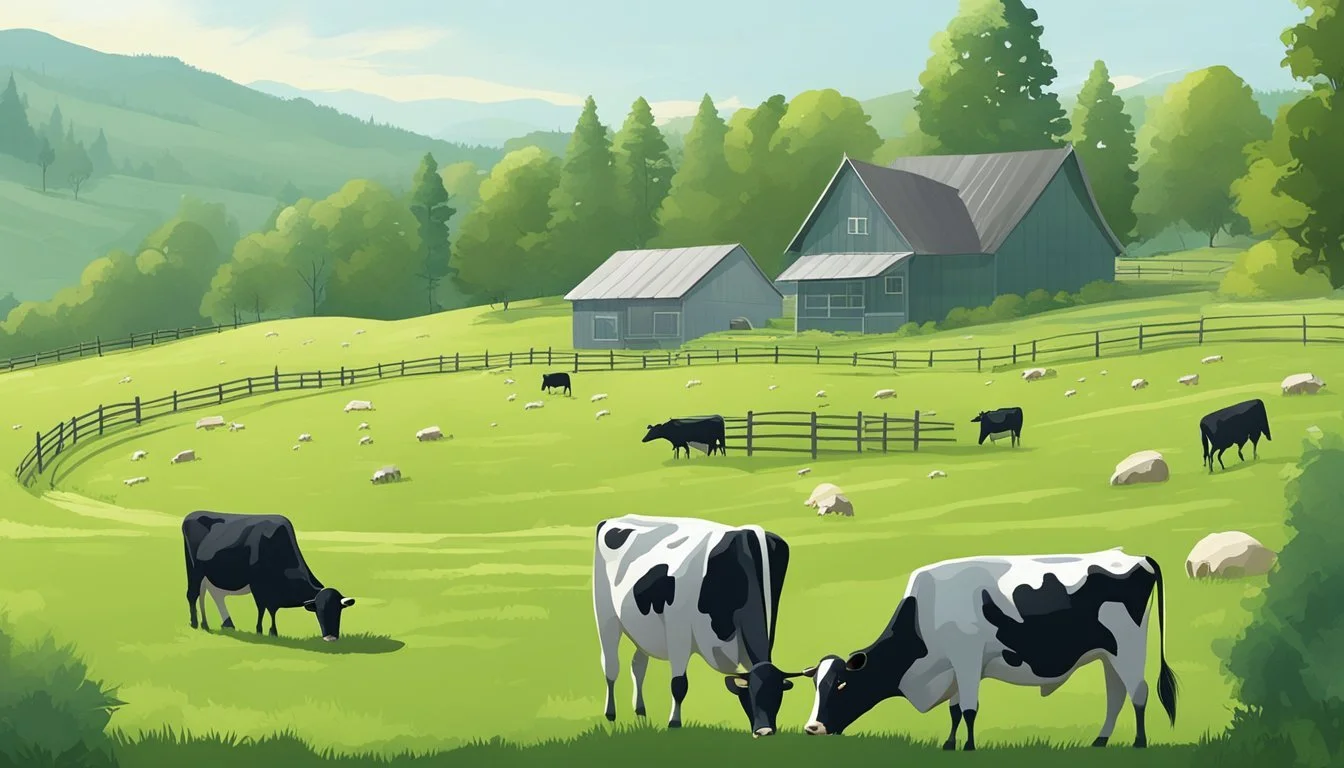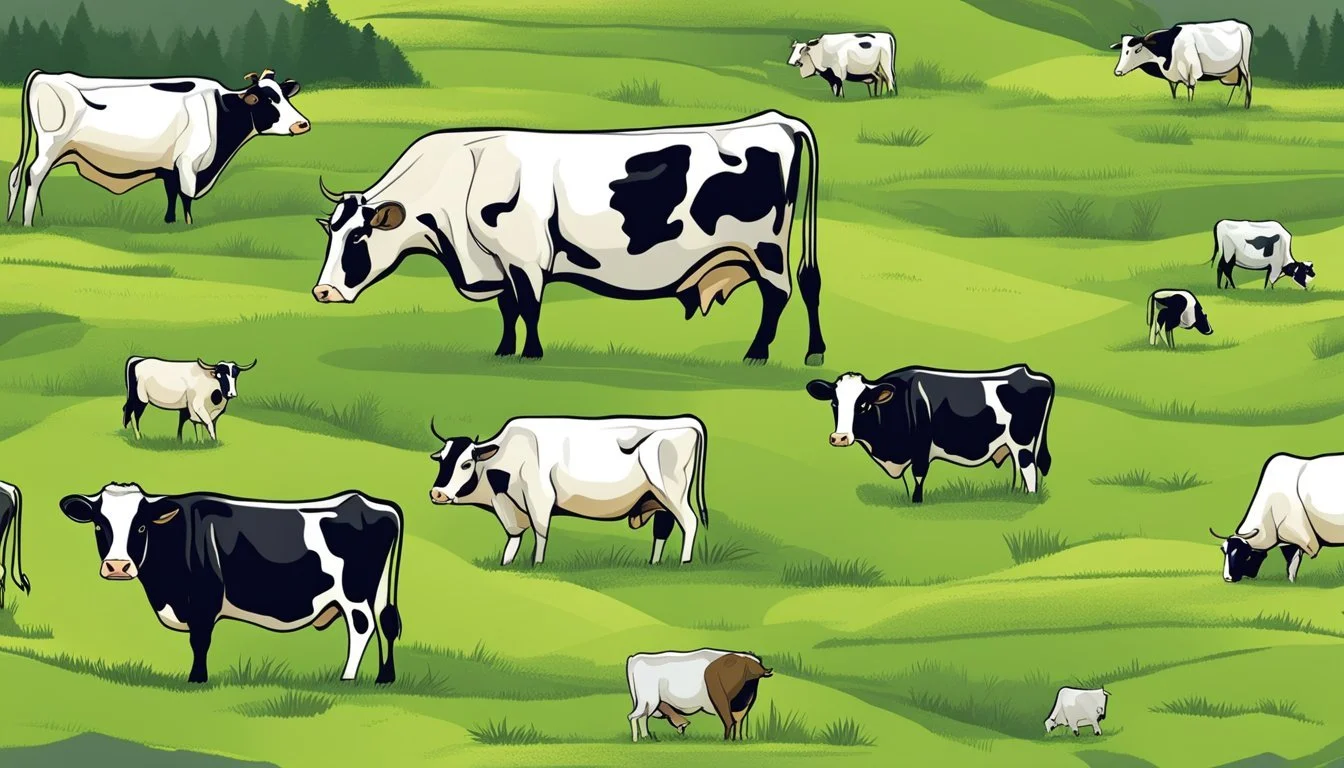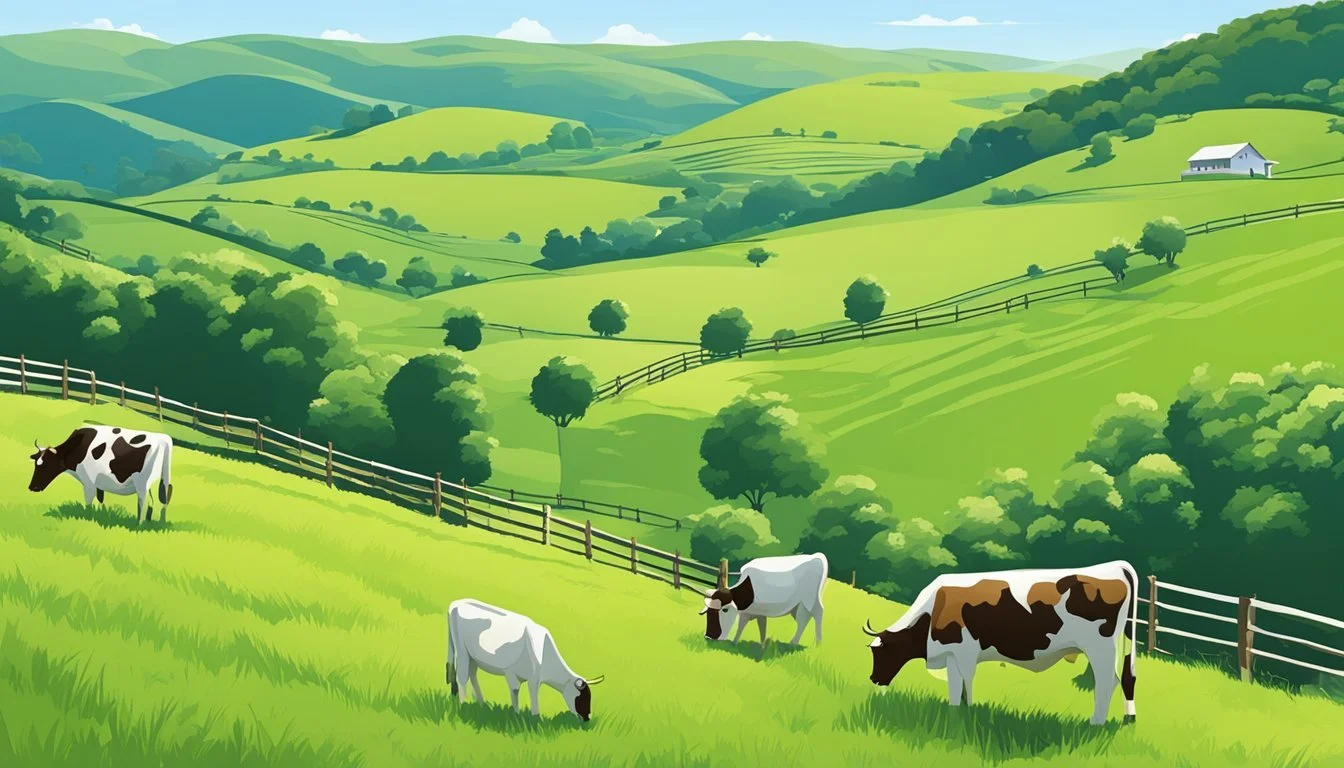Stocking Rate California
Determining Your Land's Carrying Capacity for Cows
Determining the appropriate stocking rate for cattle in California is an instrumental part of managing pasture and rangeland health. Stocking rate refers to the number of animals per acre a land area can support without causing long-term damage to the vegetation or soil. In California, the diverse climate and geography mean that the number of cows per acre a property can sustainably support varies significantly. Factors that influence this number include the quality of forage, local climate conditions, and pasture management practices.
In the drier, unirrigated rangelands of the Sierra Foothills, for example, it might require 15-18 acres to support a single 1,200-pound cow for a year. In contrast, irrigated pastures in other parts of the state can potentially support one cow on as little as one acre during a 6-month grazing season. This fluctuation underlines the importance of understanding local forage production and conducting careful pasture management to maintain an appropriate balance between the land's capacity and the livestock's needs.
Stocking rates are not only crucial for the sustainability of the land but also for the health and productivity of the cattle. Overstocking can lead to overgrazing, soil erosion, and a decrease in the pasture's ability to regenerate, whereas understocking may result in underutilized resources. Therefore, California cattle producers must assess their property's forage supply, match it with the nutritional demands of their herd, and adjust their stocking rates accordingly to optimize both their cattle's well-being and the productivity of their land.
Understanding Stocking Rates
Stocking rates are crucial for balancing livestock numbers with available pasture resources to maintain a productive and sustainable operation.
Defining Stocking Rate
Stocking rate is the number of livestock units, often expressed in terms of animal units (AUs), that can be sustainably grazed on a given area of land over a specific time period. The baseline measurement commonly used is one AU, which typically represents a 1,000-pound cow with her calf up to six months old.
Significance of Proper Stocking
Proper stocking is essential for the health of the cattle and land. Overstocking can lead to overgrazing, poor cattle performance, and environmental degradation, while understocking may result in underutilized pastures. Ensuring an appropriate stocking rate is key to maximizing the productivity of both the livestock and the forage resources.
Calculating Stocking Rate
To accurately calculate the stocking rate for properties in California, one must consider the specific forage availability and the forage demand of the cattle throughout the grazing season. For example, the formula looks like this:
Stocking Rate (cows per acre) = Total Available Forage (lbs) / (Average Forage Consumption per Cow (lbs) x Number of Grazing Days)
Using this, if a property has 10,000 lbs of available forage and each cow consumes 25 lbs per day over a 180-day grazing season, the stocking rate would be:
10,000 lbs / (25 lbs/day * 180 days) = 2.22 acres per cow
This formula provides the stocking rate, ensuring that cattle have sufficient forage and that the pasture is managed sustainably.
Pasture Management Principles
Managing pastures for optimal livestock support is a balancing act that hinges on forage quality and the grazing method employed. These components are fundamental for maintaining a healthy pasture and sustaining a desired stocking rate in California.
Importance of Forage Quality
Forage quality directly impacts the well-being of cattle and the productivity of a pasture. It is essential to assess the nutritional value of forage, which includes protein content, energy, mineral levels, and fiber digestibility. High-quality forage supports better weight gain in cattle and reduces the need for supplemental feeding. Forage quality can be managed by:
Monitoring plant species composition to ensure a mix that meets cattle nutritional needs.
Implementing soil fertility programs to maintain nutrient-rich pastures, including proper pH balance and adequate levels of nitrogen, phosphorus, and potassium.
Harvesting forage at the optimal time to maximize nutritional value, usually at early maturity stages.
Rotational Grazing vs. Continuous Grazing
Rotational Grazing involves dividing a pasture into smaller areas (paddocks) and moving livestock between them to allow forage in previously grazed paddocks to recover.
Pros: Promotes uniform forage utilization, improves pasture regrowth, reduces soil compaction, and allows for greater stocking density.
Cons: Requires more infrastructure and management to control grazing patterns.
Continuous Grazing allows cattle to graze on a single large area for a prolonged period.
Pros: Less labor-intensive and requires minimal infrastructure.
Cons: Can lead to overgrazing in certain areas, reducing forage quality and causing soil erosion.
The choice between rotational and continuous grazing depends on management goals and available resources. Rotational grazing is generally recommended for maximizing forage usage and maintaining pasture health.
Factors Influencing Stocking Decisions
When determining how many cows a property can support in California, several key factors come into play, notably forage production and land and soil quality. These elements directly affect the stocking rate and ensure sustainable livestock management.
Forage Production
Forage production is the foundation upon which stocking rates are based. It refers to the amount and quality of edible plant material that land can produce for grazing animals. In California, forage production varies greatly due to the state's diverse climate and ecosystems ranging from wet coastal areas to dry inland regions.
Annual Rainfall: Affects the growth rate and total biomass of forage crops.
Grass Types: Different grasses have varying nutritional content and growth patterns.
Forage Management Practices: Well-managed pastures yield more usable forage over time.
Example:
Region Average Forage Production (lbs/acre) Coastal Areas 4,000 - 6,000 Inland Valleys 2,000 - 4,000
These figures illustrate the potential variability in forage production, which is critical for stocking decisions.
Land and Soil Considerations
Land quality and soil composition are pivotal in supporting healthy forage growth, affecting both quantity and quality of available grasses for the herd.
Soil Fertility: A direct influencer on the types of forage that can be grown.
Topography: Slope and elevation can limit forability and affect water drainage patterns.
Soil Texture and Structure: These determine water retention and root penetration, influencing how well forage plants grow.
In relation to the herd, understanding the carrying capacity of the land is essential to avoid overgrazing, which leads to soil degradation and reduced forage availability.
Takeaway: The stocking rate in California can vary widely, and careful consideration of forage production and land and soil health is necessary for successful livestock management. These factors can guide a producer to align herd size with the sustainable productivity of their property.
Assessing Pasture Conditions
When determining the stocking rate for cattle in California, assessing the quality and condition of pasturelands is crucial. Individuals must consider multiple factors that directly influence forage yield and sustainability.
Forage Yield: The amount of edible plant material that pastures can produce is a key determinant for stocking rate. Accurate measurement of forage mass is essential. A common method is clipping a known area and weighing the dry matter produced.
Soil Health: Healthy soil underpins productive pastures. Assessing soil involves analyzing its structure, compaction levels, nutrient content, and moisture capacity. Soil tests can give insight into fertility status and help in formulating a soil management plan.
Soil Degradation: Land managers must be vigilant against degrading signs such as erosion, compaction, and nutrient depletion. These issues reduce forage quality and pasture productivity.
To maintain a supportive environment for cattle, one must ensure good ground cover and avoid overgrazing, which leads to soil exposure and degradation. Regular monitoring, proper rotational grazing schemes and allowing for rest periods can prevent overuse and promote sustainable pasture management.
In summary, evaluating pasture conditions is not a one-time task but an ongoing process that requires attention to detail and an understanding of the interplay between forage yield, soil health, and livestock needs. This careful management ensures that the land can support the appropriate number of cows per acre in California.
Cattle and Pasture Types
In California, the successful support of cattle per acre hinges on understanding the specific needs of cattle breeds and selecting adaptable forage varieties that thrive in the local climate.
Breed-Specific Needs
Different cattle breeds have varying forage requirements, especially when considering dairy cattle versus beef cattle. For instance, dairy breeds such as Holsteins and Jerseys generally require higher-quality forage due to their elevated nutritional needs for milk production. In contrast, beef breeds like Angus and Herefords may have lower forage requirements but require ample space to support their growth and weight gain objectives.
Adaptable Forage Varieties
The forage types in California must be resilient and adaptable to the region's climate and soil conditions.
Grasses: A foundation of forage is often made up of perennial grasses. In California, suitable choices include:
Tall fescue
Orchardgrass
Bermuda grass
Clover: Known for its nitrogen-fixing abilities, clover is an excellent forage that can be integrated into pasture systems. Varieties like white and red clover are common choices that provide high nutritional value.
Rye: Annual rye grass can be planted for quick growth and provides a nutritious option for grazing cattle. It can also serve as a cover crop, offering soil health benefits.
By aligning breed-specific needs with the proper selection of adaptable forage varieties, ranchers can optimize their property's carrying capacity and maintain sustainable grazing practices.
Feeding Strategies and Supplements
When determining the appropriate stocking rate in California, incorporating the correct feeding strategies and supplement plans is critical to support livestock's dietary needs, particularly under varying forage conditions.
Balancing Diet with Forage
The cornerstone of any cow's diet on a grazing property is the forage they consume. High-quality forage such as alfalfa or clover can form a substantial part of the diet; however, the nutritional value of available pasture can fluctuate. Farmers should assess forage quality and forage consumption rates frequently to ensure cows receive all necessary nutrients. Silage and hay may supplement the forage, particularly when the latter's nutritional value falls short or during dry seasons.
Forage Test: Perform routine forage tests to evaluate nutritional quality.
Supplement Accordingly: If forage is low in protein or minerals, integrate supplements to balance the diet.
Seasonal Feeding Adjustments
The feeding strategy must adapt to seasonal changes, which impact both the quantity and quality of natural forage. During the wetter months, forage quality typically rises, and cows may require less supplemental feed, whereas, in dryer seasons, the need for additional hay or silage increases.
Adjustment recommendations:
Wet Season: Monitor forage growth and reduce supplements as necessary.
Dry Season: Increase hay and silage to compensate for poor pasture conditions.
Anticipating these changes and proactively adjusting the feeding plan helps maintain the herd's health and milk production while managing the property's forage resources sustainably.
Measuring and Adjusting Stocking Rates
Accurate measurement and adjustment of stocking rates are crucial for sustainable grazing management. Proper evaluation helps ensure that the land's resources are not overtaxed, and the livestock's needs are met throughout the grazing season.
Conducting Pasture Inventory
The first step in managing stocking rates is to conduct a thorough pasture inventory. This involves assessing the quantity and quality of forage available across different pastures. One should document:
Types of forage present: Identify the species of grasses, legumes, and other plants.
Forage density: Estimate the amount of usable forage in pounds per acre.
Pasture condition: Evaluate soil conditions, signs of erosion, and plant health.
This inventory allows land managers to establish baseline values for the forage on their property and make informed decisions about how many animals the land can support.
Utilizing Animal Unit Months (AUM)
Animal Unit Months (AUM) serve as a standard metric in determining stocking rates. AUM is defined as the amount of forage required to sustain one animal unit, typically a 1000-pound cow with her calf, for one month.
Calculate AUMs: One must first establish the Average Monthly Production of forage per acre and contrast this with the herd's monthly consumption.
Adjust to Utilization Rates: The Utilization Rate, often set between 25% to 50%, directly impacts AUM calculations to prevent overgrazing and ensure sufficient regrowth. The grazing season length also plays a role, with shorter seasons potentially allowing for higher stocking rates.
For example, if an acre produces an average of 600 pounds of forage per month, and the utilization rate is 30%, the available forage per acre per month is 180 pounds (600 lbs * 0.30). If one cow-calf pair requires 600 pounds of forage monthly, then it would require approximately three acres per month per cow-calf pair (600 lbs / 180 lbs).
By conducting detailed pasture inventories and employing AUM calculations, property owners can develop and adjust their stocking rates to align with their unique Californian landscape, thereby ensuring a balance between livestock production and resource conservation.
Environmental Considerations
When planning the stocking rate in California, environmental considerations are crucial, focusing on sustainable practices to prevent overgrazing and promote biodiversity.
Mitigating Overgrazing
Overgrazing can lead to detrimental effects such as soil erosion, reduced vegetation quality, and desertification. To mitigate these risks, it's essential to determine an appropriate carrying capacity based on the animal unit month (AUM) metric, which calculates the amount of forage a single animal unit can consume in one month. Ranchers should apply rotational or controlled grazing methods to allow grasslands time to recover and prevent overuse of a single area.
Promoting Biodiversity
Biodiversity within a ranching ecosystem promotes resilience and ecological balance. Managers are encouraged to implement diverse grazing patterns and maintain a variety of plant species to support a wide range of wildlife. By planning grazing to mimic natural patterns, ranchers can foster rich habitats that support both livestock and native species, maintaining a balanced ecosystem and contributing to overall sustainability.
Grazing Regulations and Policies
In California, grazing regulations and policies are crucial for sustainable ranching and land management. They dictate how many head of cattle a rancher can sustain on their property, ensuring a balance between livestock needs and environmental conservation.
Key Regulatory Bodies:
Bureau of Land Management (BLM): Oversees public lands, authorizing grazing based on Animal Unit Months (AUM).
California Rangeland Trust: Works to conserve private rangeland.
Grazing Permit Requirements:
Ranchers must acquire a permit for grazing on public lands.
Permits include specifics on the number of cattle allowed and duration of grazing.
Stocking Rate Guidelines:
Stocking rates vary based on land quality and climate.
A common estimate is 1 to 2 cows per acre to maintain pasture health.
Sustainable Practices: Ranchers are encouraged to adopt rotational grazing to prevent overgrazing and land degradation.
Allotment Management:
Size of allotment is based on sustainable yield of the land.
Ranchers must adhere to the set number of AUMs granted by the BLM.
Monitoring and Compliance:
Regular inspections ensure adherence to permits.
Non-compliance can result in reduced AUMs or revoked permits.
Environmental Considerations:
Ranchers must practice grazing that protects soil resources, water quality, and native plant species.
Impact assessments may be required to gauge grazing's ecological effects.
It's imperative for ranchers in California to stay informed and compliant with these regulations to support their livelihoods and maintain ecological equilibrium.
Innovative Practices in Grazing
The latest advancements in grazing strategies for California cattle operations include the incorporation of multi-species grazing and utilization of technology to optimize grazing management. These practices present opportunities to maximize land use efficiency and maintain sustainable ecosystems.
Multi-Species Grazing
Multi-species grazing involves the strategic use of different livestock species to graze the same land in a manner that benefits both the livestock and the pasture. Each species has its own grazing patterns and preferences, resulting in a more uniform use of the forage resources. For instance, cattle may graze on the taller grasses while goats can manage brush and weeds, thus controlling invasive species. Moreover, this can lead to improved soil health as different animals contribute to the natural fertilization through their distinct manure compositions.
Technological Advances in Grazing Management
Technological innovation plays a significant role in modern grazing management. One technology that many in California have adopted is the use of GPS-based grazing tools to monitor livestock movements. Additionally, advanced software is now available that can help manage grazing rotations, track growth rates of forage, and provide analysis for predicting future grazing capacities. These technologies serve as a custom option for optimizing the stocking rate and ensuring that each acre is utilized to its full potential without being overgrazed. With tools such as electronic tagging systems, managers have real-time data at their fingertips to make informed decisions.
Economic Aspects of Stocking
The stocking rate on a cattle farm directly influences its profitability and revenue streams. It's essential to balance the number of cattle per acre to optimize economic outcomes.
Calculating Profitability
To calculate profitability in cattle farming operations within California, farmers must consider the carrying capacity of their land alongside operational costs. For instance, one may need approximately 1.5 to 2 acres per cow-calf pair on good quality, irrigated pasture. A conservative estimate for California's unirrigated rangelands is 15-18 acres per cow. Variable costs such as feed, veterinary services, and transportation play significant roles, as does the market price for meat. Fixed costs include land payments, equipment, and structures, which do not change with the number of cattle. Using a formula, where profitability equals total revenue minus total costs, is a straightforward way to estimate potential financial outcomes.
Revenue Calculation:
Meat Sales: Price per pound x Weight of cattle
By-products: Sales from hides, etc.
Cost Calculation:
Fixed Costs: Land, equipment, and structures
Variable Costs: Feed, healthcare, transportation
Impact of Stocking on Revenue
Stocking rates impact revenue by dictating how many cattle a farm can sustain without degrading pasture quality or incurring additional feed costs. Optimal stocking rates ensure cattle have enough quality forage, thereby maximizing weight gain and meat production. Conversely, overstocking can lead to overgrazing, poor animal health, and lower weight gains, reducing the revenue potential from meat sales. Advertising (ads) plays a vital role in commanding higher prices for meat products, emphasizing the need for effective marketing strategies to boost profitability.
Optimal Stocking:
Ensures adequate forage
Promotes healthy weight gain
Increases sale weights and revenue
Overstocking Consequences:
Reduces pasture quality
Necessitates additional feed costs
Lowers animal weights and sales revenue
Decisions on stocking rates must take into account the long-term sustainability of the cattle operation and land resources to maintain consistent revenue streams.
Case Studies and Examples
In the Sierra Foothills of California, ranchers typically require 15-18 acres of unirrigated annual rangeland to support one average-sized cow (1,200 lbs) throughout a year. This figure reduces significantly on irrigated pasture, where just one acre may suffice for a 6-month grazing season.
For more intensive operations, a study showed a producer with 50 head of 1,000-lb cows on 200 acres for a year resulting in a stocking rate of 0.33 acres per Animal Unit Month (AUM) or 4 acres per Animal Unit Year (AUY). Here's a breakdown:
Operation Description Stocking Rate Calculation Resulting Stocking Rate 200 acres, 50 head of cattle, full year Total Land Area ÷ [(#AUs) x (Grazing Season)] 0.33 acres/AUM
Another illustrative example for calculating stocking rates proposes:
If a cow/calf pair equates to 1.4 Animal Units (AU),
And the grazing season lasts for 6 months,
With a recommended stocking rate of 2
This example implies the need for 4.2 acres per cow on a farm:
(1.4 AU x 6 months) / Stocking Rate of 2 = 4.2 acres
When ranchers in California assess their operations, they consider cattle type, duration of the grazing days, and the balance between land health and livestock needs. Stocking rates are dependent on multiple factors including pasture quality, irrigation, and herd management practices.
Such assessments ensure sustainability and productivity in California's diverse ranching landscapes. These case studies highlight the necessity for tailored grazing strategies that meet specific land conditions and livestock requirements.
Conclusion
In California, determining the appropriate stocking rate for cattle is critical for sustainable land management. The carrying capacity of a property is influenced by several factors, including land quality, climate, and pasture size. A standardized measure commonly used is the Animal Unit Month (AUM), which represents the feed needed for a 1,000-pound cow and its calf for one month.
Table: Example Stocking Rates for Calfornia
Pasture Type Estimated AUM per Acre Annual Rangeland 0.1 - 0.5 AUM Irrigated Pasture 1 - 4 AUM
Property owners must assess their specific conditions, as these rates can vary. For example, irrigated land typically supports a higher stocking rate than dry rangeland.
It is essential to monitor grazing patterns and adjust the number of cattle accordingly to prevent overgrazing. Implementing rotational grazing can also maximize pasture use and sustain animal health. Moreover, frequent assessment of pasture health and productivity is advisable to ensure the land can support the desired number of cattle.
When considering the number of cows per acre, farmers should employ a conservative approach, erring on the side of understocking to accommodate fluctuations and preserve the ecosystem. Responsible management aligns the stocking rate with the carrying capacity to maintain a balance between livestock needs and land resources.

